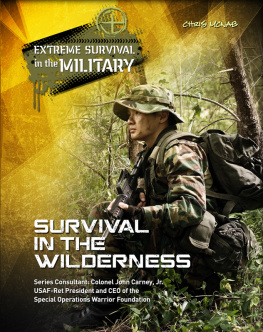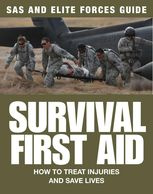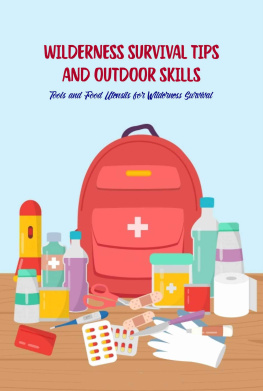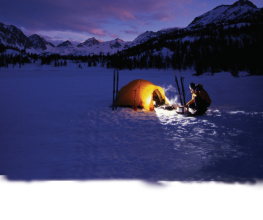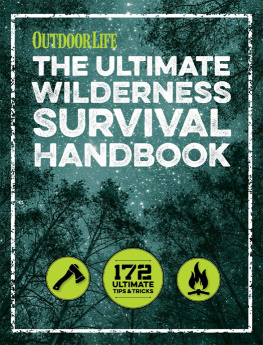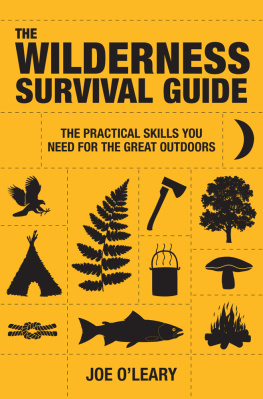EXTREME SURVIVAL
IN THE MILITARY
SURVIVAL
IN THE WILDERNESS
EXTREME SURVIVAL
IN THE MILITARY
Learning Mental Endurance for Survival
Ropes & Knots for Survival
Survival at Sea
Survival Equipment
Survival First Aid
Survival in the Wilderness
Surviving by Trapping, Fishing, & Eating Plants
Surviving Captivity
Surviving Hostage Rescue Missions
Surviving Natural Disasters
Surviving the Worlds Extreme Regions:
Desert, Arctic, Mountains, & Jungle
Surviving with Navigation & Signaling
EXTREME SURVIVAL
IN THE MILITARY
SURVIVAL
IN THE WILDERNESS
CHRIS McNAB
Introduction by Colonel John T. Carney. Jr., USAF-Ret.
President, Special Operations Warrior Foundation
MASON CREST
Mason Crest
450 Parkway Drive, Suite D
Broomall, PA 19008
www.masoncrest.com
Copyright 2015 by Mason Crest, an imprint of National Highlights, Inc. All rights reserved. No part of this publication may be reproduced or transmitted in any form or by any means, electronic or mechanical, including photocopying, recording, taping, or any information storage and retrieval system, without permission from the publisher.
Printed and bound in the United States of America.
10 9 8 7 6 5 4 3 2 1
Series ISBN: 978-1-4222-3081-7
ISBN: 978-1-4222-3087-9
ebook ISBN: 978-1-4222-8779-8
Cataloging-in-Publication Data on file with the Library of Congress.
Picture Credits
Australian Army: .
Illustrations courtesy of; Amber Books, De Agostini UK and the following supplied by Patrick Mulrey: .
ACKNOWLEDGMENT
For authenticating this book, the Publishers would like to thank the Public Affairs Offices of the U.S. Special Operations Command, MacDill AFB, FL.; Army Special Operations Command, Fort Bragg, N.C.; Navy Special Warfare Command, Coronado, CA.; and the Air Force Special Operations Command, Hurlbert Field, FL. |
IMPORTANT NOTICE
The survival techniques and information described in this publication are for educational use only. The publisher is not responsible for any direct, indirect, incidental or consequential damages as a result of the uses or misuses of the techniques and information within. |
DEDICATION
This book is dedicated to those who perished in the terrorist attacks of September 11, 2001, and to the Special Forces soldiers who continually serve to defend freedom. |
An elite soldier takes part in a wilderness survival course. Given very little provisions, he must fend for himself in extreme conditions.
Elite forces are the tip of Freedoms spear. These small, special units are universally the first to engage, whether on reconnaissance missions into denied territory for larger, conventional forces or in direct action, surgical operations, preemptive strikes, retaliatory action, and hostage rescues. They lead the way in todays war on terrorism, the war on drugs, the war on transnational unrest, and in humanitarian operations as well as nation building. When large scale warfare erupts, they offer theater commanders a wide variety of unique, unconventional options.
Most such units are regionally oriented, acclimated to the culture and conversant in the languages of the areas where they operate. Since they deploy to those areas regularly, often for combined training exercises with indigenous forces, these elite units also serve as peacetime global scouts and diplomacy multipliers, a beacon of hope for the democratic aspirations of oppressed peoples all over the globe.
Elite forces are truly quiet professionals: their actions speak louder than words. They are self-motivated, self-confident, versatile, seasoned, mature individuals who rely on teamwork more than daring-do. Unfortunately, theirs is dangerous work. Since Desert Onethe 1980 attempt to rescue hostages from the U.S. embassy in Tehran, for instanceAmerican special operations forces have suffered casualties in real world operations at close to fifteen times the rate of U.S. conventional forces. By the very nature of the challenges which face special operations forces, training for these elite units has proven even more hazardous.
Thus its with special pride that I join you in saluting the brave men and women who volunteer to serve in and support these magnificent units and who face such difficult challenges ahead.
Colonel John T. Carney, Jr., USAF-Ret.
President, Special Operations Warrior Foundation
A thick, waterproof jacket, insulating hat, and stout walking boots are an essential part of any wilderness survival kit.
WORDS TO UNDERSTAND
improvise: Make something using whatever is handy.
operation: A military activity.
thermal: Material thats designed to keep heat from leaving your body.
dehydrated: Dried; all water removed.
The soldiers of the Special Forces need clothing that will withstand hostile weather and terrain. Good equipment is also vital. A few key items can mean the difference between life and death. This chapter explains the principles they teach for selecting clothing and gear for backpacking in wild areas. All travelers should carry the right equipment to help them overcome any disasters that they may face.
If you have just survived a plane crash or similar accident, the chances are that you will be dressed in light, comfortable clothes that are totally unsuitable for survival situations. This being the case, you must improvise . However, if you are a backpacker or adventurer, you should be better clothed and equipped to deal with a survival situation. There is really no excuse for wearing inappropriate clothing and carrying poor equipment. Today, there is an amazing variety of clothing available to the backpacker. Above all, you must select the proper clothing for the job.
But how do you know how to equip yourself? Simple: read this book, go through magazines dedicated to outdoor pursuits, go to camping exhibitions, go to camping and survival stores, and talk to the staff who have a knowledge about such things. In short, like members of the Special Forces, find out about your operation before you set out. By doing this, you will not find out the hard way that your clothing is totally unsuitable for the wilderness.
Gore-Tex is an excellent material for outdoor clothing. It is a breathable material. This means that it lets tiny drops of sweat exit but prevents water from entering. Such amazing material is not cheap, but what price do you put on your life? Of course, just wearing a Gore-Tex jacket is not enough. In the wilderness, the weather can go from bright, hot sunshine to freezing winds in a matter of hours, particularly if you are on a remote hillside or deep in an isolated woodland. That is why you should follow what the worlds Special Forces and survival experts call the layer principle.
The layer principle is very simple. The more layers of clothing you wear, the warmer you will be. Temperature control is very easy. If you are too hot, take off clothes; if you are too cold, put on clothes. Remember, getting too hot can be as much of a problem as being too cold. If you sweat when it is cold, the body chills when you stop sweating, and your sweat-soaked clothing will draw away body heat into the air. It is important that you prevent this. Here are the layers you should wear:
Next page
